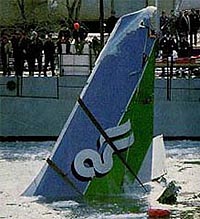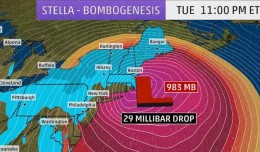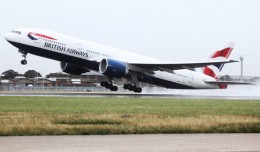(Editors Note: With the winter season upon us, it’s a good time to look back at our feature on how airlines keep ice from impacting flight safety. This article was originally published in January 2012.)
A winter storm has moved into the area, giving you some concern on both your drive to the airport and flight itself. Your flight is delayed and airport operations are busy plowing the runways and taxiways. After boarding is complete, the aircraft is sprayed down, the snow removed, and the aircraft taxis out to the runway. You can’t help but think of the 1982 Air Florida disaster. Should you be concerned? No, because the Captain is.

The tail section of Air Florida’s Flight 90 during recovery.
Thirty years ago this month, Air Florida Flight 90 crashed after departing Washington National Airport, laden with ice. The crew had improperly deiced the aircraft and improperly operated the Boeing’s engine anti-ice system. Combined, the 737 was incapable of flight, resulting in the deaths of almost all on board and five people on the 14th Street Bridge.
Six years after Air Florida, Continental flight 1713 crashed on takeoff at Denver Stapleton Airport. Though the aircraft had been properly deiced, it had not been adequately anti-iced. With flight surfaces contaminated with ice during the taxi out and aggravated by the First Officer’s aggressive piloting, the aircraft stalled on takeoff, killing most of the crew and a third of the passengers. Just four years later, an improperly anti-iced USAir flight 405 departed LaGuardia’s runway 13; unable to climb, it crashed into Flushing Bay.
These three accidents forever changed how winter weather operations in the United States are conducted.
In the early days of passenger airline service, adverse winter weather simply halted all flights. The airborne de-icing systems that came into use in the late 1930’s and 1940’s allowed airlines to expand operations into altitudes and weather conditions that were previously unattainable. Ice buildup on the ground was removed from aircraft with brooms, hot water, or just polished smooth and left on the aircraft.
Today, polishing ice and leaving it on the wing is no longer permissible. And although the other techniques may still be utilized on rare occasions, the most common method for removing ice from an aircraft is spraying it with “Type I” (one) deicing fluid; a mix of water and glycol alcohol, tinted orange, and heated to 170 degrees. Essentially a specialized automotive antifreeze.
Though highly effective, the economic and environmental costs of deicing with glycol are substantial. To alleviate this, less toxic glycol solutions and deicing pads that recover the fluids for recycling have been developed, and additional alternative methods of deicing are under development.

A 747 inside JFK’s Radiant De-Icing facility.
In 1998, an infrared aircraft deicer was installed at the Rhinelander airport in Wisconsin. Essentially an open-ended shed, with active infrared panels that heat and melt the ice on the aircraft. Similar facilities have been made operational at New York’s international airports, Newark and JFK. These infrared systems have shown promise. (Editor’s note: these systems have since proven to be ineffective in most situations. At JFK, the “deicing tent” would really only be useful when taking off from one particular runway, and then o let in certain weather and airfield conditions. The tent has been decommissioned and is now used for covered storage and VIP use for the nearby FBO.)
Another alternative method for deicing that has been under development is using the exhaust from a small jet engine mixed with deicing fluid. Reliable and effective results have not been attained, but testing continues.
In rare circumstances, the aircraft may not be required to deice prior to takeoff. If the wing is cold, and cold dry snow or ice pellets are falling, they will not adhere to a wing that has not been deiced. In this case, since the wing is free of contaminants, the departure is safe and permissible.
After deicing is complete, and if icing conditions have ceased, the aircraft is clean and ready for departure. If the snow or sleet persists, it will quickly start adhering to the wings and flight control surfaces. The orange Type I fluid will provide a minimal amount of resistance against the ice accumulating on the wings. If the snow is light and the taxi times are short, it is sufficient. Otherwise, an additional fluid must be applied, a green colored glycol called “Type IV” (four).
The goopy Type IV is an anti-ice fluid that sticks to the wing and readily absorbs the precipitation that would otherwise cause ice to form on the wing. The Type IV fluids will typically provide thirty to forty five minutes of protection depending on the amount of precipitation and temperature.

These guys have their work cut out for them. (Photo by Zee71)
Each year, these fluids are evaluated to determine reasonable amount of times that they can be expected to be effective. If these times are exceeded during taxi, the fluid may fail to prevent ice accumulation on the wing. Prior to failure, a glossy reflective finish on the fluid denotes that it is still effective, whereas a satin and opaque finish indicates the fluid has failed, and ice may be adhering to the wing. Pilots may leave the cockpit prior to departure to visually evaluate conditions for themselves, and if the fluid has failed, the aircraft will need to return for deicing.
If the fluid is holding, the aircraft is safe for departure. On takeoff, passing through 115 miles per hour, the glycol will begin flowing off the wing. The fluids that cleaned and protected the wing from ice are now stripped away. You may think that this is concerning, but in fact it is required.
The FAA’s regulation and “Clean Aircraft Concept” require that ice be removed from the wing prior to takeoff. This also applies to the glycol fluids. Once the aircraft is airborne, the onboard deicing and anti-icing systems will protect it. The Type I and IV fluids are not designed to provide in-flight deicing, and if they are not shed on the takeoff roll, they can disrupt the airflow over the wing with potential catastrophic results. When temperatures drop below minus twenty five degrees, the glycol will congeal and remain on the wing after takeoff. In this case, an alternative method must be used to deice the aircraft, otherwise the flight is grounded.
On the ground, ice forms on the top of the wings, fuselage, and tail surfaces. Once airborne, the ice forms on the leading edges. Aircraft can have deicing systems, which will remove this ice after it forms, or anti-ice systems which keep ice from forming, or a combination of these. Heat, alcohol, vibration, speed, and dynamic surfaces are all methods employed for in-flight deicing and anti-icing systems.
In the 1930’s, air transportation moved into the realm of “all weather operations”. In addition to gyroscopic instruments and radio navigation that allowed “blind flight” into clouds, deicing and anti-icing systems allowed flight in clouds with temperatures below freezing, where ice exists.
These early aircraft utilized inflatable “boots”, mounted to the leading edges of the wings and tail. These are de-icing systems; they allow ice to build then radically change shape by inflating which removes the ice. The boots are then deflated, resuming the shape of the wing and the process starts over. These boots are easily identifiable as black leading edges on the wings and tails of vintage propeller airliners and modern turboprop aircraft.
To keep ice from forming on the windshields and propellers, they are either bathed in an alcohol or electrically heated. Since the ice never forms, these are considered anti-ice systems. Probes that measure airspeed, altitude, and the angle of the airflow are electrically heated and are also anti-ice systems.
The British operating in severe icing conditions of the North Sea developed an alternative way to deal with flight into icing conditions, wings with porous leading edges made from wood and pressurized alcohol behind them. The alcohol would slowly weep through the wood and keep ice from forming on the wings. The wooden leading edges were soon replaced with porous metal that accomplishes the same thing. The British continue to use this system, most notably on the Hawker line of business jets, and it has also been fitted to many small American built piston and turboprop aircraft.
The advent of the jet age also ushered in a new type of system to deal with in-flight icing, the heated wing. The Boeing 707, Douglas DC-8, and Convair 880 all took heated compressed air from the engines, and passed it through the leading edges of the wings and tail. The “hot wing” has proven itself extremely effective and reliable in icing conditions, and is a staple of turbojet aircraft.
Vibration, typically an undesirable trait, can be an effective anti-icer. The vibration found in the tail of aft engine T-tailed jets can keep ice forming on those surfaces. In these cases, the vibration was unintentional, but in some cases, it is a design aspect. Most modern turbojet engine nose cones, or spinners, are pointed and unheated. The out of round spinner creates a vibration that shakes off any ice. In the decades prior, these spinners were round and had to be heated, consuming a tremendous amount of engine power. The vibrating pointed spinner is more efficient, reliable and lighter. One corporate jet manufacturer had even experimented with a wing incorporating an ultrasonic leading edge. This wing would not accumulate any ice even in the most severe conditions, but apparently had insurmountable problems that have retained it from production. A Long Island based company has developed a similar system with good results.
One type of deicing isn’t a system at all, but rather speed. At speeds under 200 miles per hour, air simply flows over and around an aircraft like water around a boat. But unlike water, air is compressible, and passing through 200 miles per hour, air simply can’t get out of the way fast enough. It eventually flows around the aircraft, but only after being compressed which heats it up. The aircraft is bathing in an airflow that can be as much as thirty degrees warmer. This process can resist or even remove ice formation.
The technology and knowledge exists to keep aircraft on the ground and in flight free of detrimental ice. With proper ground and in-flight deicing, crew training, and regulatory oversight, accidents like Air Florida 90, Continental 1713, and USAir 405 are unlikely to occur again. Your concern with recollection of these accidents is understandable. The Captain also remembers these accidents, and will protect the airliner and its passengers. And you.
David J. Williams is a former airline Captain and currently involved with aviation safety.







